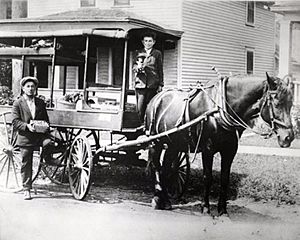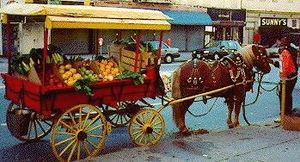Arabber facts for kids
An arabber is a special kind of street vendor. They sell fresh fruits and vegetables from colorful, horse-drawn carts. Arabbers were once very common in cities along the East Coast of America. Today, only a few arabbers still work in Baltimore. They use unique street cries (loud calls) to let customers know they are nearby.
Contents
The History of Arabbers

The word arabber probably comes from an old term, "street Arabs." This term was used in the 1800s for people who lived and worked on the streets. Arabbing started in the early 1800s. It was an easy way for people to start their own small business, especially if they had access to ships or stables.
After the American Civil War, many African Americans joined the arabbing trade. Their carts were often brightly painted and arranged with care. These carts became a common sight on the streets of Baltimore. To let people know they were coming, arabbers created special calls. These calls were like songs or chants.
Here is an example of an arabber's call:
Holler, holler, holler, till my throat get sore.
If it wasn't for the pretty girls, I wouldn't have to holler no more.
I say, Watermelon! Watermelon!
Got 'em red to the rind, lady.
Challenges and Changes
During World War II, many factory jobs opened up for white workers. This meant that arabbing became a job mostly done by African-American men. But even then, the number of arabbers was already going down. New supermarkets were opening, making it easier for people to buy groceries. Also, public stables, where arabbers kept their horses, started to disappear.
Later in the 1900s, arabbers faced more problems. City rules about zoning (how land can be used) and vending (selling things) made it harder for them. Also, groups that protect animal rights became concerned about the health of the horses.
Keeping the Tradition Alive
In 1994, a group called the Arabber Preservation Society was started. Their goal was to help save the stables where arabbers kept their horses. One stable, on Retreat Street in Baltimore, was in bad shape. The society helped fix it up to meet city rules.
The society still works to keep the remaining arabber stables in good condition. Today, there are fewer than a dozen arabbers left. But they still play an important role. They bring fresh fruits and vegetables to city neighborhoods that don't have many grocery stores. These areas are sometimes called food deserts.
Arabbers often don't know everything about horse care. So, they have formed a special connection with Old Order Mennonites in Pennsylvania. Mennonites live a rural lifestyle with horses and carriages. They share their knowledge and help arabbers find and buy horses.
Arabbers in Popular Culture
Arabbers have appeared in movies and TV shows:
- The documentary We Are Arabbers (2004) shows what life is like for arabbers today. It was made by Scott Kecken and Joy Lusco Kecken.
- Arabbers are seen in seasons 1, 4, and 5 of the TV series The Wire. Joy Lusco Kecken, who made the documentary, also wrote for this show.
- In season 1 of the TV series Homicide: Life on the Street, there is a story about an arabber. This series is based on a book by David Simon, who also created The Wire.
- On an episode of the TV show Ace of Cakes in 2009, an arabber was mentioned.
See Also
- Hawker (trade)
- Street cries


